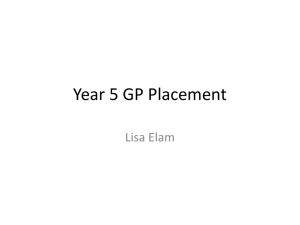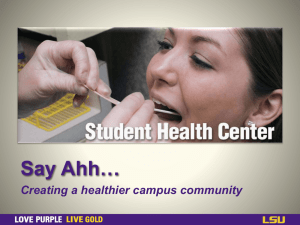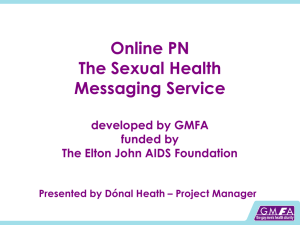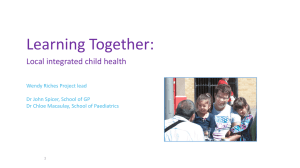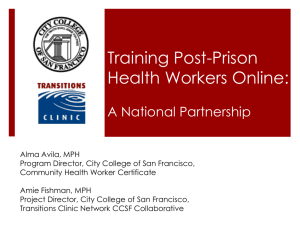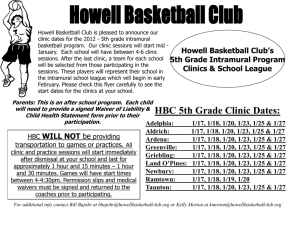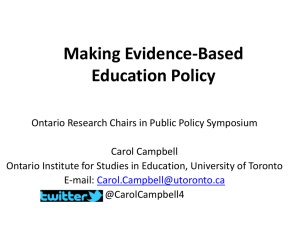Challenges and Opportunities - Community Advocacy & Legal Centre
advertisement
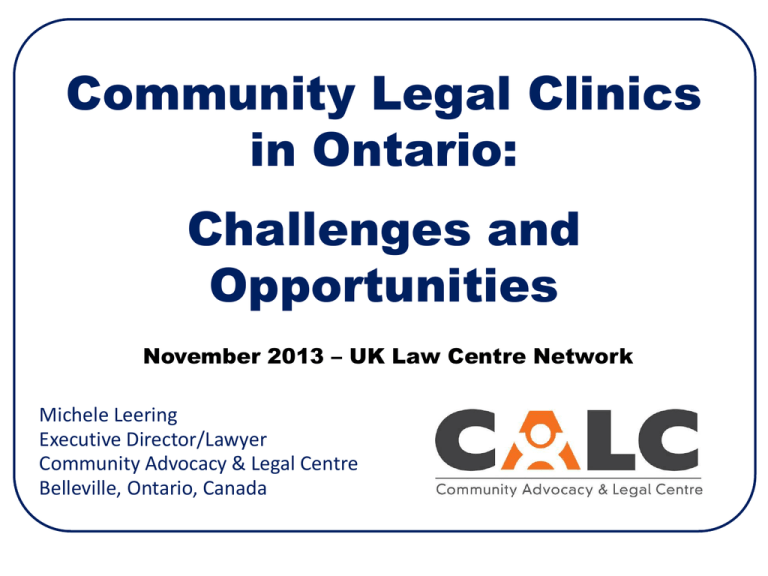
Community Legal Clinics in Ontario: Challenges and Opportunities November 2013 – UK Law Centre Network Michele Leering Executive Director/Lawyer Community Advocacy & Legal Centre Belleville, Ontario, Canada Locating Legal Aid and Ontario’s community legal clinics Canada Ontario Population (2011 Census): 33,476,688 Population (2011 Census): 12,851,821 Overview of Ontario’s Legal Aid System Ministry of Attorney General (Main funder) Legal Aid Ontario (LAO) LAO Direct Client Services LAO Certificate Program – Private Lawyers (Judicare) Independent Community Legal Clinics University Student Legal Clinics (SLASS) Expenditures by Program Area – 2011/12 New approach post-2009 for LAO family, criminal and immigration services http://www.legalaid.on.ca/en/publications/downloads/annualreport_2012.pdf Client Intake and Advice - LAO District Offices and new experimental services (Family Law Office, Refugee Law Office, Family Law Service Centres, Family Justice Centres (domestic violence) space-sharing with community legal clinics Legal Aid Websites Toll-free telephone number to Client Service Centre (summary legal advice, legal aid certificates) Poor people and the law Poor people are not just like rich people without money. Poor people do not have legal problems like those of private plaintiffs Poverty creates an abrasive interface with society; poor people are always bumping into sharp legal things. Poor people do not lead settled lives into which the law seldom intrudes; they are constantly involved with the law in its most intrusive forms. Stephen Wexler, Practicing Law for Poor People, 79 Yale Law Journal 1049 (1970) Clinics & Poverty Law – Common Areas of Law : General Service” Clinics Landlord & Tenant Consumer Law Workers’ Rights Criminal Injuries Compensation Income Security and Benefits Human Rights Education Rights “Speciality” Clinics University Student Legal Clinics – also known as Student Legal Aid Services Societies (SLASS) SLASSs at six Ontario law schools staffed by law students close supervision of experienced lawyers Cases include: minor crimes; poverty law Clinics and Poverty Law Services Clients can call toll-free – their local CLC Clients can visit clinic office or satellite locations or via community partners “trusted intermediaries” Clients can access information online via website, Facebook blogs and Twitter Law Reform and systemic advocacy activities Clients represented at Administrative Tribunals and Courts and other forums Public Legal Education and Information (PLEI) activities, outreach events, workshops, community capacity-building and organizing, community development Preventative Legal Services Access to Justice - Challenges in rural areas: A poverty law perspective, May 8 2012 Queen's University Professionals in Rural Ontario: An Interdisciplinary Approach 6 Experimental “Appropriate Intervention Point” Analysis Housing Search Safe Tenancy Housing Loss Cycle of Housing Instability Eviction Order Arrears / Repairs Legal Awareness Needed Notice Dispute Application Original diagram from Eviction Prevention and its Relation to Homelessness, Acacia Consulting & Research Final Report, March 2006 VISION Poverty reduction and enhanced access to justice in Ontario through a diverse and dynamic system of community-based and client-focused legal clinics. GUIDING PRINCIPLE FOR PROVINCIAL STRATEGIC PLANNING Clinics work together as a system to make best use of our collective strengths to better serve and empower our clients while maintaining accountability to our individual communities. VALUES Client-driven poverty law services Representative governing boards of directors Trained, experienced, valued staff Transparency and open communication among clinics Collaborative decision making Close collaboration with community and justice sector partners Dignity, respect and a culture that does not stigmatize Independence from government Accountability and responsiveness to the communities we serve Providing a voice for marginalized communities Commitment to equity and social justice Access to Justice Challenges Responding proactively and positively Growing challenges …. Access to Justice gap Rising legal costs and decreasing legal aid $ Private bar disengagement with legal aid Legal needs studies suggest different approach Rural and remote service delivery challenges Special needs – linguistic, disability, mental health Using technology effectively – internal/external Value for money audits and accountability Proactive responses Advocating for the cause of A2J: The holistic response and the justice system Leveraging new resources from within: Knowledge Management, Action Learning/Research; Appreciative Inquiry Developing a strategic plan for the clinic system: Build commitment Getting ahead of the curve: Enhance Partnerships, Evidencebased, Evaluation and Outcome Measurement Holistic service delivery (CALC’s Five County Network report (Nov. 2013) We now define holistic service delivery in the following ways: ensuring that all the clients’ legal needs and issues are identified (regardless of first point of contact with legal services) Ensuring that non-legal issues are identified and appropriate referrals are made Employing a broad range of “legal service” strategies to meet those needs including referral, information, advice, representation, community capacity building (including outreach, public/community legal education, and community development activities), and systemic advocacy and law reform strategies. Holistic Service Delivery Holistic Service: A service that looks at the client as a whole to assist with their legal and non-legal issues, well-being and empowerment. The service is tailored to assist the person with their specific issues in connection, rather than in a fragmented or piecemeal way which ignores their circumstances or other factors that may be affecting their lives. It may also involve working with legal and non-legal agencies and other people whose rights are being affected. Curran, L. Encouraging Good Practice in Measuring Effectiveness in the Legal Service Sector. (Legal Workshop, Australian National University College of Law: May 2013), 3. The holistic approach to client service focuses upon an analysis of what the client community needs to get ahead rather than an exclusive focus on the client's immediate request for services. The holistic strategy for helping clients involve: ● An analysis of the full scope of a client's situation, not just the issues the client presents; ● An identification of the advocacy strategy which will address the client's myriad needs; and ● The mobilization of resources to meet those needs. Neiman, T. Reflections on Holistic Advocacy, Management Information Exchange Journal, 34, 36–37 (Fall 1999) Holistic service is sometimes used to infer a broader notion of service than seamlessness. Several notions of service can be invoked in the name of holistic provision. Understanding: Seeing a client’s legal problems in their wider social context, and addressing the legal problem within that context. For instance, this might include acknowledging the impact of a client’s mental health, disability of caring obligations on their ability to solve their ‘legal’ problems. Diagnosing: Diagnosing and dealing with all of a client’s legal problems (i.e. going beyond the presenting problem or the problem that a particular adviser is geared up to deal with, to see what other legal needs might be present). Delivering or networking: Ensuring a client receives appropriate levels of advice on their legal problems through appropriate provision by the adviser themselves, or through referral/signposting to colleagues or other providers in the system. Broadening: Seeing a client’s non-legal problems as requiring some level of intervention if the client’s legal problems are to be addressed and delivering those interventions directly or through signposting/ referring the client to the relevant services and ensuring those services are carried out. Taking some strategic initiative: Identifying and tackling the root cause of a client’s legal problems (to use a medical analogy, tackling causes not symptoms). Moorhead, R. Coping with Clusters? Legal Problems Clusters in Solicitors’ and Advice Agencies. Paper to the International Legal Aid Group, 2007, 19-20. Retrieved November 13, 2013 from www.ilagnet.org/jscripts/tiny_mce/plugins/filemanager/files/Antwerpen_2007/Conference_Papers/Coping_with_ Clusters_Legal_problems_clusters_in_solicitors_and_advice_agencies.pdf. Experimental “Legal Health” Checklist Approach www.communitylegalcentre.ca/legal_information/Tips/LegalHealthChecklist.pdf Working with Access to Justice Partners Creating strategic alignment and possibilities for increased collaboration Increasing Access to Justice Trusted Intermediaries Legal Aid Law Foundation and NGO’s Community Legal Clinics University Student Legal Clinics University Law Faculties Government, Courts & Members of Parliament Law Societies, Bar Associations and Pro Bono Lawyers Expanding Our Vision Quality poverty law legal services: Healthy legal clinic system Coordinating legal aid service delivery: Healthy Legal Aid system Increasing access to real Justice Proactive responses Advocating for the cause of A2J: The holistic response and the justice system Leveraging new resources from within: Collaboration, Knowledge Management, Action Learning & Research; Appreciative Inquiry… Developing a strategic plan for the clinic system: Build commitment Getting ahead of the curve: Enhance Partnerships, Evidencebased, Evaluation and Outcome Measurement Credible Portal to Legal Information “Knowledge Management Systems” What do we mean by this? Culture is more critical than technology Work processes must integrate KM components Develop, share and create new knowledge KM starts with you! Personal Knowledge Management “KM” KnowledgeNow Project www.aclco.org/Knowledge_Now.html Tools for a Learning Organization Organizing Deep Dive Journeys Encouraging “Double Loop” Learning Creating Reflective & Generative Dialogue The Five Whys* Prototyping – Promising Practices Facilitating Appreciative Inquiry approaches Encouraging Reflective Practice: A Working Conceptualization Reflecting in Community Reflection on Practice (skill) Critical Reflection (knowledge) Self-reflection (values) Integrated Reflective Practitioner Leering, M. Forthcoming paper Proactive responses Advocating for the cause of A2J: The holistic response and the justice system Developing a strategic plan for the clinic system: Build commitment Leveraging new resources from within: Knowledge Management, Action Learning/Research; Appreciative Inquiry Getting ahead of the curve: Enhance Partnerships, Evidencebased, Evaluation and Outcome Measurement Legal Aid’s Key Strategic Objectives for clinics 2013 Expanding access to justice and providing fair and equal access to clinic law services Providing a continuum of client-focused, high-quality, cost-effective services while promoting innovation Meeting the highest standards of public administration in Ontario, including the highest standards of transparency and accountability Providing more and better services in a more costeffective way Proactive responses Advocating for the cause of A2J: The holistic response and the justice system Developing a strategic plan for the clinic system: Build commitment Leveraging new resources from within: Knowledge Management, Action Learning/Research; Appreciative Inquiry Getting ahead of the curve: Enhance Partnerships, Evidencebased, Evaluation and Outcome Measurement Cartoon by Leo Cullum, The New Yorker, November 30, 1998 ILAG 2013 Navigating with the Wandering Lost: The Critical Role of Trusted Intermediaries in Increasing Access to Justice http://prezi.com/3vt4ni2zmez1/ilag-presentation-for-ilag-website-june-14-2013/ Why Trusted Intermediaries? Build an expanded justice system by integrating community resources and legal services Key strategy Intermediaries: the fence at the top of the cliff Possible “Spectrum” of Legal Literacy and Capability Training for “Trusted Intermediaries” Legal Awareness Understanding legal information vs. legal advice Spotting or redflagging legal issues Making good legal referrals Understanding available legal services (Legal Aid, pro bono, sliding scale) Legal Advocacy Using the internet and printed materials effectively to find legal information Community navigation – advocacy & other help available Using social networking technology to find and update legal information Developing basic legal research skills Developing a “reflective practice” Developing knowledgesharing networks Understanding the law: Legal issue workshops Understanding the legal system Working effectively with your client’s Advocating lawyer or effectively for advocate your client Understanding how to use the law (process & enforcement) Working with clients to encourage selfadvocacy & self-help Identifying systemic issues for advocacy Developing sophisticated legal research skills June 2013 Why outcome and performance measurement?? You’ve got to be careful if you don’t know where you’re going ‘cause you might not get there. Yogi Berra Not everything that can be counted counts, and not everything that counts can be counted. Albert Einstein Experience has taught me that justice is not a fixed destination that we reach, but an illusive and continuous journey that we undertake and embrace. Justice does not stand at the end of the legal rainbow waiting for us to arrive and discover it. Prof. David Hall (June 2005) (former Dean of Northeastern University School of Law), Pathways to Justice Conference in California. Questions? For further information: leeringm@lao.on.ca www.communitylegalcentre.ca www.facebook.com/CommunityLegalCentre www.legalaid.on.ca Ontario’s Legal Clinics A broad spectrum of strategies, grounded in community needs & capacities • Ontario’s 77 community legal clinics approach the delivery of legal services to hard to reach communities in creative and innovative ways. Clinics are not-for-profit, based in communities (geographic and interest), governed by local Boards of Directors, and employ lawyers, community legal workers and intake and support staff. Approaches to service delivery are holistic and integrated and include: direct services to clients outreach and community development, and systemic advocacy and law reform. • To find out more about the unique structure of legal clinics and the Ontario legal clinic system see, “Critical Characteristics of the Community Legal Aid Clinics in Ontario” at: http://www.aclco.org/f/Critical_Characteristics.pdf • A detailed discussion of our legal clinics is found in the article written by Osgoode Hall Law Professor Janet Mosher, “Poverty Law: A Case Study prepared for the Legal Aid Review” at http://www.communitylegalcentre.ca/about_us.htm. Additional references Legal Aid Review 1997 www.attorneygeneral.jus.gov.on.ca/english/about/pubs/olar/ch11.asp Legal Aid Review 2008 www.attorneygeneral.jus.gov.on.ca/english/about/pubs/trebilcock/ Clinic System Strategic Plan 2013 http://www.aclco.org/public_docs/strategic_planning_docs/2012-1212Update_to_clinics-Strategic-Planning-Strategic-Plan-Final.docx KnowledgeNOW www.aclco.org/Knowledge_Now.html Comparing and Understanding Legal Aid Priorities Mary Jane Mossman (2009) www.aclco.org/public_docs/legalaidpriorities.pdf
